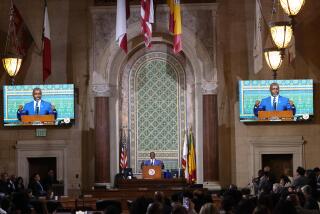ARTS PANEL: STATUS QUO PREDICTED
- Share via
Gov. George Deukmejian is about to gain a more powerful hold over the California Arts Council than he’s ever had before--tantamount to the influence exerted by former Gov. Edmund G. (Jerry) Brown Jr.
In January, Deukmejian will make four appointments to the 11-member council, bringing the number of current members he’s appointed to a majority of nine. In fact, this is the maximum number of appointees the governor can have. The remaining two members are legislative appointments.
The Arts Council, which awards taxpayers’ dollars to music, dance, theater, visual and other arts groups throughout the state, could be reshaped in this changing of the guard. Not a single council member appointed by Brown, who pushed for creation of the council in 1976, will remain.
However, most of the outgoing members--all Brown appointees who served at least four years--don’t foresee a dramatic alteration of council ideology or policy. Retiring members Stephen Goldstine, current council chairman; Noah Purifoy; Bella Lewitzky; and Wendy Goldberg say they are generally optimistic about the council’s future.
“Intuition says Republican appointees will probably be more interested in large, established organizations,” Goldstine noted recently. “But my experience has been that when people come on the council, they learn about the smaller, emerging groups and activities that they had no awareness of before, and they tend to be impressed with what comparatively modest funding accomplishes. So at least through the Deukmejian Administration,” he said, “there’s been a decidedly populist response to funding support.”
Since Deukmejian took office in 1983, he has appointed three business professionals and two arts administrators to the council. All are Republican, although the governor is under no constraints to appoint members of his own party.
In fact, council Executive Director Robert Reid, also a Deukmejian appointee, lobbied to have outgoing member Lewitzky, who calls herself “an independent in my work and in my politics,” reappointed to the council. Lewitzky declined, pleading her Los Angeles dance troupe’s busy international touring schedule.
Outgoing member Purifoy, the only member to have served on the council since its inception, said, “I feel comfortable with the council people we now have because they don’t think any one discipline is better than the other. We have to be careful about the feud out there in the state among disciplines. I think there’s an equitable distribution of dollars now.”
Purifoy, also the only black member currently on the council, doesn’t expect council programs to change. “I think the programs we have now are too well solidified in the minds of the people in the field, the people they serve. These people won’t stand for a change.”
Outgoing member Goldberg, founding president of the Filmex Society (and wife of Leonard Goldberg, new president of 20th Century Fox Film Corp.), noted that she crossed party lines to vote for Deukmejian in November. “So far the governor’s appointees have been terrific,” she said. “And I think he’ll continue to increase the council’s budget.”
According to Reid, “The long-range change from the Brown Administration to the Deukmejian Administration is that there’s a fundamental difference of opinion about how much public money should be used for the arts. I think the new council has realized that it’s a mix of public and private dollars, not just public money all by itself.”
However, Reid, who is widely credited with helping the council win a 6.3% budget increase this fiscal year following a zero increase from the year before, noted that a more conservative council wouldn’t necessarily hamper further budget increases in the short term. “There will be less rhetoric perhaps, but more behind-the-scenes support of our budget.”
Lewitzky, the only full-time professional artist currently on the council, sounded a cautionary note: “It’s been very difficult having an Arts Council with so few working artists. The problem is the one I face. If you are a working artist, finding the time to do the job that must be done on the council is very, very difficult. Yet somehow that voice must be heard. I’d like to see a better representation of working artists.”
Lewitzky also believes that the new appointees should represent the ethnic minority community. Deukmejian’s five appointees--Los Angeles Music Center administrators Laurel Dickranian and Joanne C. Kozberg, Long Beach brewer Bryan (Whitey) Littlefield, Orange County developer Harvey Stearn and Sacramento businesswoman Joyce Pollock--are all white. The only remaining minority member is Consuelo Santos-Killins, a Senate Rules Committee appointment.
Reid says he’ll particularly recommend ethnic minorities and working artists for next year’s appointments. A Deukmejian spokeswoman said the governor “will weigh very heavily” Reid’s recommendations.
Susan Hoffman, director of the California Confederation of the Arts, the state’s arts advocacy organization, was guarded in her predictions. “The five council members Deukmejian has already appointed obviously have more direct entree to the governor than the Brown appointees did,” she said.
Reflecting on outstanding accomplishments during their tenure, outgoing council members cited as most critical the council’s new $500,000 multicultural (ethnic minority) grant program and a developing program for individual artists, to award its first grants in 1988.
Still most in need of improvement, the members said, was the council’s 47 cents-per-capita budget, which this year totaled $13.5 million. The confederation, as well as the Joint Legislative Committee on the Arts, wants to see the state’s per-capita arts spending double to $1 by 1990. New York now spends about $2.50 per capita.
More to Read
The biggest entertainment stories
Get our big stories about Hollywood, film, television, music, arts, culture and more right in your inbox as soon as they publish.
You may occasionally receive promotional content from the Los Angeles Times.










